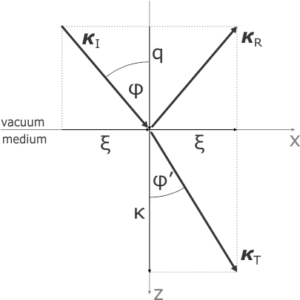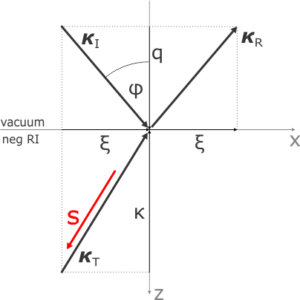$\setCounter{0}$
Part 1: The wave vector
Part 2: The interface
Part 3: The s-polarization
Part 4: The p-polarization
Part 5: Multilayers
In this second part we will have a look what happens to electromagnetic waves at a planar interface between vacuum and isotropic material. First, without going into the textbook-level details here, we just remind ourselves that the Maxwell’s equations demand certain continuity of the \(\bf{E}\), \(\bf{H}\), \(\bf{D}\), \(\bf{B}\) fields at the interface. Particularly, the two equations with divergences will fix that the normal components of the \(\bf{D}\) and \(\bf{B}\) fields will be conserved across the interface. The two equations with rotations will then demand continuity of the in-plane components of the \(\bf{E}\) and \(\bf{H}\) fields.
\(
\begin{align}
\begin{aligned}
\mathbf{D}_{\perp 1}&=\mathbf{D}_{\perp 2},
&\mathbf{B}_{\perp 1}&=\mathbf{B}_{\perp 2},
\\
\mathbf{E}_{\parallel 1}&=\mathbf{E}_{\parallel 2},
&\mathbf{H}_{\parallel 1}&=\mathbf{H}_{\parallel 2},
\end{aligned}
\end{align}
\)
where the index 1, 2 denotes the first and the second medium.
Let’s choose our coordinate system. The interface will be the \(x-y\) plane at \(z=0\). We can freely orient our system so the incoming wave propagates in the \(z-x\) plane. We know that the field above the interface (in vacuum in our case) is composed of the incoming and the reflected wave, and there will also be the transmitted (refracted) wave in the second medium, which is isotropic material with both \( \varepsilon \) and \( \mu \) responses, i.e. generally frequency \( \omega \) dependent, but we excluded the points where \( \varepsilon \) or \( \mu \) are equal zero.

One important consequence of the continuity of the fields at the interface is that the x-components of the wave vectors of our three waves must be equal. And we remember that the magnitude of the wave vector was fixed by the eq. (10) in Part 1. This will lead to the fact that the angle of reflection is equal to angle of incidence, \(\varphi\) , and for the refracted wave, the Snell’s law is valid.
Here we should note that the Snell’s law in the textbook form, \( n_{1}\sin\varphi = n_{2}\sin\varphi’ \), in only meaningful for transparent materials with real \( n_1 \) and \( n_2 \). Otherwise, when the second medium is absorbing, with \( N_2=n_2+ik_2 \), we end up with complex \(\sin\varphi’ \).
In our picture, working with the geometrical components of the wave vectors, we will denote the x-component \( \xi = \sin\varphi \) (will always be non-negative real), and write the Snell’s law in general form
\(
\begin{align}
\xi=\text{const.}
\end{align}
\)
This is also valid for any layer in multilayer stack, as long as the interfaces are parallel. Here, we will also denote the z-component of the incoming wave as \( q = \cos\varphi \) and the z-component of the transmitted wave as plain \( \kappa \).
\(
\begin{align}
\begin{aligned}
\boldsymbol\kappa_{I}&=(\xi,0,q),
\\
\boldsymbol\kappa_{R}&=(\xi,0,-q),
\\
\boldsymbol\kappa_{T}&=(\xi,0,\kappa).
\end{aligned}
\end{align}
\)
Now, without writing it down, we remind ourselves that all the fields come with the phase factor in the form \( e^{i k_0 \kappa z} \cdot e^{i k_0 \xi x} \cdot e^{-i \omega t} \), where \( k_0 \equiv \frac{\omega}{c} \) is the physical magnitude of the wave vector in vacuum (with inverse length unit). So the problem is stationary in time \( t \), as well as in \( x \), we can cancel the the two exponential factors, and are left only with the z-propagation using the relevant \( \kappa \). Also, wherever possible, we cancelled the \( \frac{\omega}{c} \).
The geometrical z-component of the wave vector, \( \kappa \), is calculated from eq. (10) in Part 1
\(
\begin{align*}
\varepsilon\mu=\xi^{2} + \kappa^{2},
\end{align*}
\)
i.e.
|
\( \begin{align} \kappa = \sqrt{\varepsilon\mu – \xi^{2} }. \end{align} \) |
From this generally complex square-root, we will choose the root with positive imaginary part.
The figure below illustrates the discussed configuration for the case of material with negative index of refraction, here \( n < -1 \) and \( k \) reasonably small, keeping the medium transparent. The right choice of \( \kappa \) is therefore with negative real part, so the transmitted wave travels apparently towards the interface, while its amplitude is decreasing with increasing distance from the interface. The Poyinting vector \( \bf{S} \) shows that the energy flows into the medium.
